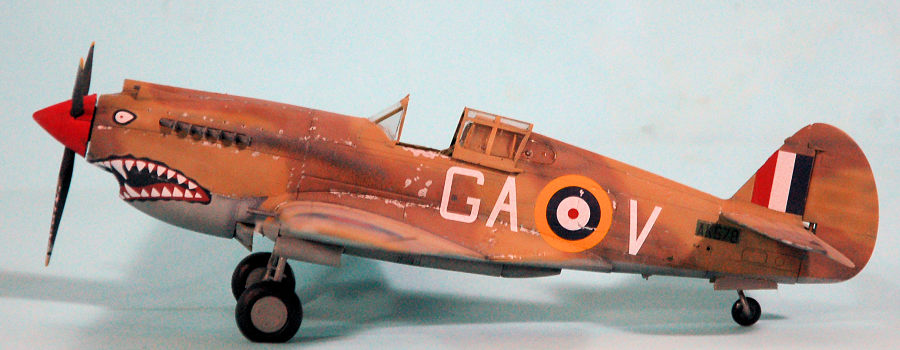
| KIT #: | A 05133 |
| PRICE: | $29.95 |
| DECALS: | Two options |
| REVIEWER: | Tom Cleaver |
| NOTES: | Xtradecal X48162 “Early Curtiss P-40s Part 2" |

| HISTORY |
With war clouds on the sky in 1938, the Army Air Corps determined it needed a fighter with better performance than the P-36. Curtiss had developed a design strategy stretching back to the P-1 if stretching an airframe as far as possible, and their proposal to essentially re-engine the P-36 with an Allison inline engine was quickly accepted.
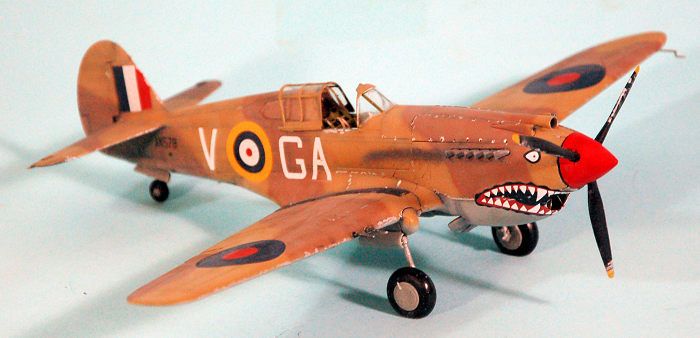 The XP-40,
which was the tenth P-36 airframe, first flew on 14 October 1938. The glycol
radiator was positioned under the fuselage aft of the wing. Speed in this
configuration was a disappointing 315 mph, not a significant improvement on the
P-36. Curtiss engineers went to work and developed a more streamlined radiator
positioned under the Allision V-1710 engine. One the basis of the expected
improvements, 524 P-40s were ordered in April 1939, the largest production
contract for a USAAC fighter to that time. Further tests in December 1939 showed
a top speed of 366 mph.
The XP-40,
which was the tenth P-36 airframe, first flew on 14 October 1938. The glycol
radiator was positioned under the fuselage aft of the wing. Speed in this
configuration was a disappointing 315 mph, not a significant improvement on the
P-36. Curtiss engineers went to work and developed a more streamlined radiator
positioned under the Allision V-1710 engine. One the basis of the expected
improvements, 524 P-40s were ordered in April 1939, the largest production
contract for a USAAC fighter to that time. Further tests in December 1939 showed
a top speed of 366 mph.
As originally conceived the P-40 was a pursuit aircraft and while it was very agile at low and medium altitudes, it suffered due to lack of power at higher altitudes since it had only a single-stage supercharger. At medium and high speeds it was one of the tightest-turning early monoplane designs of the war, and could hold its own with European designs it met in combat in North Africa and on the Russian front.
The first production P-40s appeared in the summer of 1940. The armament of two .50 caliber weapons was deemed inadequate, and the P-40B that appeared that fall carried two .30 caliber machine guns in each wing. The original models were later upgraded during the war with a single .30 caliber weapon in each wing as the P-40G. By early 1941, the P-40C appeared, plumbed to carry a 50-gallon drop tank under the fuselage.
In 1940, the British Purchasing Commission contracted with Curtiss for delivery of what was termed the Tomahawk I, which was the P-40B. The contract was changed in April 1941 with passage of the Lend-Lease Act, and the Tomahawk II, equivalent to the P-40C, began to be delivered to the RAF shortly thereafter. Tests of the aircraft in the UK revealed its limitations regarding altitude, which meant it could not be used as a standard fighter. Additionally, it was not as maneuverable as its lighter progenitor, the P-36/Hawk 75A. The aircraft was turned over to the Army Cooperation Command for use in the fighter-reconnaissance role until it was replaced by the superior North American Mustang I.
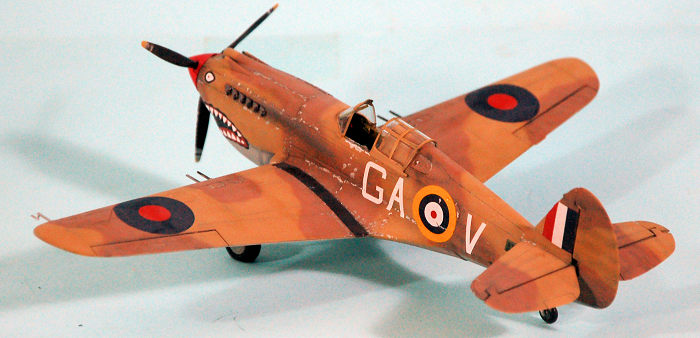 Shortages
of Hurricanes and an inability to send Spitfires to the Mid-East in 1941, saw
the Tomahawks diverted to Egypt for use with the Desert Air Force where the
Italians were not considered as much of a threat as was the Luftwaffe. The
fighter was superior to the Hurricane in speed and overall performance. When the
Bf-109s of the Afrika Korps’ JG 27 arrived, the Tomahawk was outclassed but
remained in first line service. The Tomahawk was generally considered roughly
equal to the Bf-109 at low altitude but inferior at high altitude, particularly
against the Bf 109F. Since most air combat in North Africa took place well below
16,000 ft, this meant the Bf-109 could use its superior high altitude
performance to attack the Tomahawks in a dive. The Tomahawk had an advantage
over the Bf 109 in turning, dive speed and structural strength, was roughly
equal in firepower but was slightly inferior in speed and outclassed in rate of
climb and operational ceiling. Hans-Joachim Marseille, an extremely gifted
marksman and pilot, once shot down 17 Tomahawks from a Lufbery circle, using the
Bf-109F’s dive and zoom capability and his incredible shooter’s eye. His final
score of 158 victories included 101 Tomahawk II and Kittyhawk I (P-40E)
fighters.
Shortages
of Hurricanes and an inability to send Spitfires to the Mid-East in 1941, saw
the Tomahawks diverted to Egypt for use with the Desert Air Force where the
Italians were not considered as much of a threat as was the Luftwaffe. The
fighter was superior to the Hurricane in speed and overall performance. When the
Bf-109s of the Afrika Korps’ JG 27 arrived, the Tomahawk was outclassed but
remained in first line service. The Tomahawk was generally considered roughly
equal to the Bf-109 at low altitude but inferior at high altitude, particularly
against the Bf 109F. Since most air combat in North Africa took place well below
16,000 ft, this meant the Bf-109 could use its superior high altitude
performance to attack the Tomahawks in a dive. The Tomahawk had an advantage
over the Bf 109 in turning, dive speed and structural strength, was roughly
equal in firepower but was slightly inferior in speed and outclassed in rate of
climb and operational ceiling. Hans-Joachim Marseille, an extremely gifted
marksman and pilot, once shot down 17 Tomahawks from a Lufbery circle, using the
Bf-109F’s dive and zoom capability and his incredible shooter’s eye. His final
score of 158 victories included 101 Tomahawk II and Kittyhawk I (P-40E)
fighters.
The
Tomahawk was superior to the Italian Macchi C.200 Saetta and Fiat G.50 Freccia,
but was inferior to the Macchi C.202 in maneuverability and speed, though its
armament was superior. The Tomahawk was deadly against the German He-111 and
Ju-87 as well as the Bf-110, and all Italian bombers. The airplane first
entgered combat in June 1941 against the Vichy French, with the pilots of 3
Sq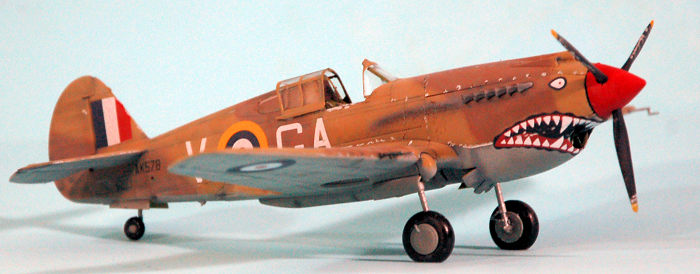 uadron RAAF claiming 19 victories over Syria in June and July.
uadron RAAF claiming 19 victories over Syria in June and July.
112 Squadron began using the Tomahawk in June 1941. The squadron became famous for its “sharkmouth” markings, which fit the sharklike shape of the Tomahawk II perfectly. These markings were adopted from seeing photos of Bf-110s of the Luftwaffe’s ZG 76 “Haifish Gruppe.”
The leading Tomahawk ace was the RAAF’s Clive “Killer” Caldwell, who began his fighting career with 250 Squadron, before transferring to 112 Squadron. In August 1941, Caldwell was attacked by two Bf-109s, one of them piloted by German ace Werner Schröer. Although he was wounded three times and his Tomahawk was hit by more than 100 7.92 mm bullets and five 20 mm cannon shells, Caldwell shot down Schröer's wingman and returned to base. In December 1941, Caldwell killed prominent German Experte, Erbo von Kageneck (69 kills).
| THE KIT |
Modelers have longed for a fully-accurate early P-40 since Monogram released theirs 52 years ago in 1964. The first of Monogram’s “serious” kits (it had no toy-like moving parts), Monogram came very close in terms of shape, and the kit is the only one ever released that accurately portrays the fact the P-40 only had flush rivets on the wing leading edge back to the main spar. The molds have long been shot, and without a Squadron/Falcon vac canopy and either a scratchbyuilt cockpit or a resin replacement, the kit has long been due for replacement.
 Twenty
years ago Hobbycraft took a shot, but missed the target when they used the wing
of their P-36 kit, which had a very different lower center section. After
botching the P-40B in 1/32, Trumpeter compounded their mistakes in 1/48 back in
2005. Hobby Boss multiplied the same errors in their kit.
Twenty
years ago Hobbycraft took a shot, but missed the target when they used the wing
of their P-36 kit, which had a very different lower center section. After
botching the P-40B in 1/32, Trumpeter compounded their mistakes in 1/48 back in
2005. Hobby Boss multiplied the same errors in their kit.
Thus, when Airfix announced a P-40B/C in 2015, and stated it would be based on research involving an actual P-40C (the airplane restored by Matt Nightingale for The Fighter Collection in 2014), there was a degree of hope expressed. The resulting kit is largely accurate, far moreso than its competition. This Tomahawk II release was manufactured in the UK, rather than India, and has better quality plastic and was produced with better quality control, ending the problem of short-shot parts and too-soft plastic in the first release.
The kit includes decals for two aircraft, a Tomahawk II in the UK operated by 26 Squadron of Army Cooperation Command, and a Tomahawk II of 112 Squadron. Additionally, Xtradecal has released several sheets for the early P-40. I opted to use their sheet X48162 “Early P-40s Part 2" since the 112 Squadron option had a more “ferocious” sharkmouth than others in the squadron.
| CONSTRUCTION |
The kit is easy to build if you follow the instructions. I did discover a couple of things that make assembly more precise. If you take your time and test fit before gluing, you can easily assemble this model without any putty or filler needed. I suggest you lightly scrape down the edges of the internal parts, because overall fit is very tight, and any little “edge” of flash will mess things up.
The one place that is more fiddly than elsewhere is gluing the lower front of the cowling in position to the radiator intake part. Airfix has you wait to do this until the fuselage halves are glued together. I found that if you glue that part to the intake part, and then glue that assembly into a fuselage half, and take the time to carefully align everything together, you will than have it perfectly aligned when you glue the other fuselage half to the sub-assembly. I also suggest that you assemble the upper cowling parts to each respective fuselage half before assembly (rather than after as Airfix suggests) because you can work the fit from both inside and outside, and get the alignment perfect.
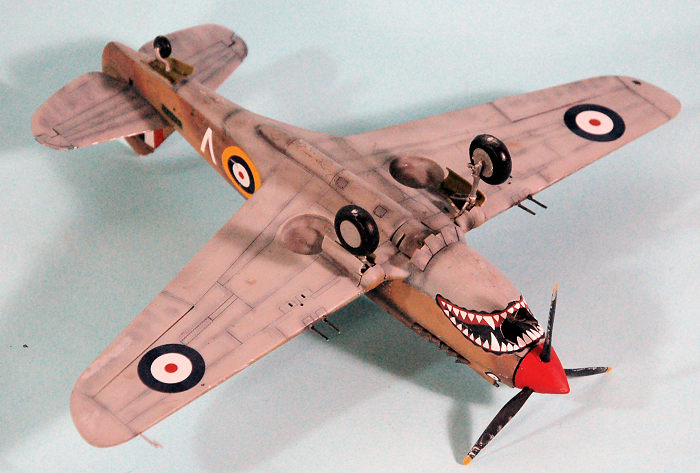 When the
wing parts are assembled, there is a noticeable gap along the trailing edge
where the flap is. This is not Airfix screwing up the fit, but rather getting it
very right. There is in fact a noticeable gap there when the aileron is raised
on the real airplane.
When the
wing parts are assembled, there is a noticeable gap along the trailing edge
where the flap is. This is not Airfix screwing up the fit, but rather getting it
very right. There is in fact a noticeable gap there when the aileron is raised
on the real airplane.
Before gluing the wing parts together, I suggest you also scrape down the inner joint of the upper wing along its edges, to insure a good fit since again everything has close tolerances when you assemble the model. Be sure you have trimmed down all sprue nubs everywhere when you cut a part off the tree. Some of the sprue gates are a little thick and you need to be sure of this to insure the nice putty-free fit you want.
A note about the cockpit color: The early P-40 cockpit is painted “tinted green,” which is Yellow Zinc Chromate mixed with Black. It is NOT “Interior Green,” but rather a more yellowish hue. I found that using Tamiya XF-4 “Yellow Green” mixed with Tamiya NATO Black got the color I wanted. The interior of the wheel wells and gear doors, including the canvas “boots” in the main wells and the tail wheel, were painted Yellow Zinc Chromate at the factory. I finished off the cockpit with an Eduard RAF sutton harness.
| COLORS & MARKINGS |
The Tomahawks originally arrived in North Africa in their original Dark Earth/Dark Green/Sky Grey camouflage, which was changed at the Aboukir maintenance facility with the Dark Green overpainted with either Light Earth or Middle Stone. While most painting instructions say the underside was Azure Blue, that was not the case with most of the Tomahawks, which were left with their Sky Grey undersides since they were needed quickly in service.
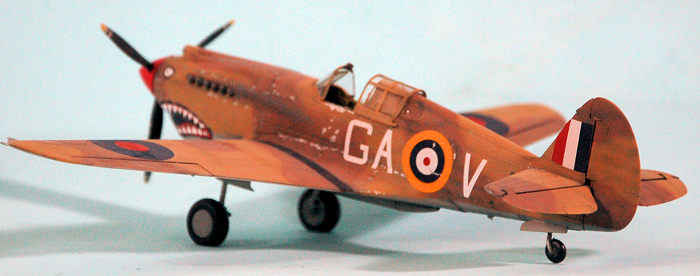 I painted
this model with Tamiya Royal Light Grey for Sky Grey, Flat Earth for Dark Earth
(since it is close to the US color used in the factory) and Desert Yellow for
Light Earth, all applied freehand with my Paasche H.
I painted
this model with Tamiya Royal Light Grey for Sky Grey, Flat Earth for Dark Earth
(since it is close to the US color used in the factory) and Desert Yellow for
Light Earth, all applied freehand with my Paasche H.
I used the kit decals for the national insignia and the Xtradecals for the sharkmouth and individual codes and serial number. When they were set, I applied a coat of very flat “clear flat” to simulate the sun-faded surface of an airplane in the desert.
I unmasked the canopy, attached the quarter panels with Micro Krystal Klear white glue and attached the sliding canopy in the open position. I then attached the landing gear and prop. I used the “fishtail” exhausts from the Spitfire XIV kit, since this was an early Tomahawk that used these kinds of exhausts. I applied staining for exhaust and the radiator with Tamiya “Smoke.”
| CONCLUSIONS |
I really like the Airfix early P-40, and particularly like it as an RAF fighter in the Desert Air Force. The kit is easy to build by any modeler with some experience, who commits the radical act of following the instructions.
27 June 2019
Copyright ModelingMadness.com
Review Kit courtesy of Hornby America. Decals courtesy of Hannant’s.
If you would like your product reviewed fairly and fairly quickly, please contact the editor or see other details in the Note to Contributors.
Back to the Main Page Back to the Review Index Page Back to the Previews Index Page